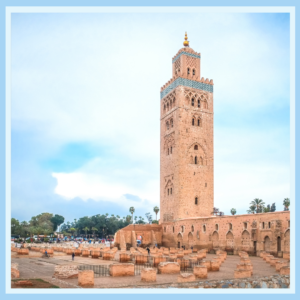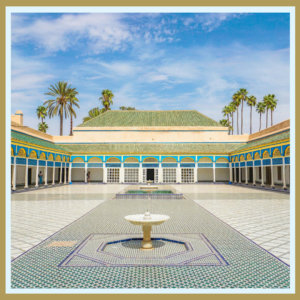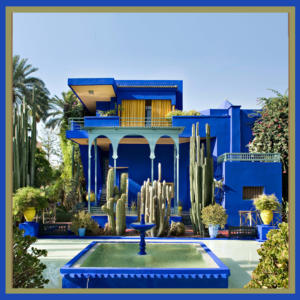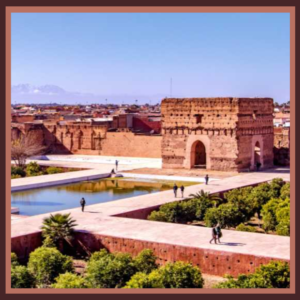Marrakech, also known as the “Red City” because of its red sandstone architecture, has a long history dating back over a thousand years. Abu Bakr Ibn Umar, the Almoravid dynasty king, built the city in 1062. It swiftly became a major centre of trade, culture, and education, attracting academics and artisans from all over the Islamic world.
Marrakech thrived during the Almoravids and, subsequently, the Almohads, who built notable structures such as the Koutoubia Mosque and the city walls. The Saadian dynasty of the 16th century brought additional riches and renowned architectural achievements, such as the Saadian Tombs and El Badi Palace.
The city expanded under the Alaouite dynasty, who dominated Morocco since the 17th century. Marrakech’s rich history is reflected in its medina, a UNESCO World Heritage Site, and thriving souks.
In the twentieth century, Marrakech became a prominent tourist destination, attracting artists, writers, and celebrities from all over the world. Today, it is still an important cultural and economic hub in Morocco, noted for its distinctive blend of heritage and modernity. Here’s a guide for arranging your trip to Marrakech:
Top Attractions:
DJemaa el-Fna
Jemaa el-Fnaa is Marrakech’s major square and bustling center. It is one of the world’s most recognised squares and a popular gathering spot for both locals and tourists.
Jemaa el-Fnaa is a must-see attraction in Marrakech that provides a sensory overload of sights, sounds, and fragrances. Whether you’re touring during the day or enjoying the lively nightlife, the square offers an unforgettable taste of Moroccan culture. https://jemaa-elfnaa.com/
Koutoubia Mosque
The mosque’s name “Koutoubia” originates from the Arabic word for “booksellers” (koutoub), as a market selling books and manuscripts once surrounded it. The design and minaret of the Koutoubia Mosque influenced the architecture of other renowned mosques, such as the Giralda in Seville, Spain, and the Hassan Tower in Rabat, Morocco.
Abd al-Mu’min, the Almohad caliph, first commissioned the mosque in the mid-12th century. Around 1147, construction began. Yaqub al-Mansur, the caliph’s grandson, reconstructed the original construction in 1199 after discovering its misalignment with Mecca.
The mosque’s minaret, which stands around 77 metres (253 feet) tall, is one of Marrakech’s most identifiable features. It was completed in 1199 and has characteristic Almohad architectural features. The mosque remains a significant religious and cultural attraction in Marrakech, serving the local Muslim population and attracting visitors from all over the world. https://www.lonelyplanet.com/morocco/marrakesh/djemaa-el-fna-around/attractions/koutoubia-mosque/a/poi-sig/1144234/1341479
Bahia Palace
Bahia Mansion is a historic mansion in Marrakech, Morocco. Si Moussa, Sultan Hassan I’s grand vizier, built it in the late nineteenth century, likely around the 1860s. Later, Sultan Abdelaziz’s grand vizier, Ba Ahmed, son of Si Moussa, expanded the palace.
The palace’s name, “Bahia,” means “brilliance” in Arabic, and the design reflects this with elaborate detailing and lavish ornamentation. The palace is vast and has courtyards, gardens, fountains, and chambers adorned with magnificent mosaics, carved wood, and colourful tiles.
The Bahia Palace is currently available to the public and is a famous tourist destination in Marrakesh. Visitors can tour the spectacular architecture and learn about the palace’s history and previous occupants. https://bahia-palace.com/
Saadian Tombs
The Saadian Tombs are an ancient mausoleum in Marrakech, Morocco. The tombs date back to the Saadian dynasty, which ruled Morocco from 1549 until 1659. They were unearthed in 1917 after being hidden for decades, and they are now a renowned tourist destination recognised for their stunning architecture and rich decorating.
The graves contain the remains of the Saadian royal dynasty, including Sultan Ahmad al-Mansur and his descendants. The tomb is a beautiful example of Islamic architecture, with delicately carved stucco, exquisite tilework, and cedar wood ceilings. The gardens around the graves contribute to the location’s peaceful atmosphere.
Visitors can tour the tombs and admire the artistry and history of this important landmark in Moroccan cultural heritage. Please let me know if you require any additional information about the Saadian Tombs or other relevant topics. https://www.introducingmarrakech.com/saadian-tombs
Majorelle Garden
Majorelle Garden, or Jardin Majorelle, is a botanical garden in Marrakech, Morocco. It was built by French artist Jacques Majorelle in the 1920s and 1930s and is notable for its vivid cobalt blue structures, abundant plant life, and peaceful ponds.
The garden contains a diverse collection of exotic plants from throughout the world, including cacti, palms, and bamboo. In addition to its floral beauties, Majorelle Garden houses the Berber Museum, which depicts the history and culture of the indigenous Berber people.
The garden was renovated in the 1980s by fashion designer Yves Saint Laurent and his partner Pierre Bergé. It’s a popular tourist destination and a stunning oasis in the heart of Marrakech. https://www.jardinmajorelle.com/en/
El Badi Palace:
El Badi Palace, located in Marrakech, Morocco, is a historical site and one of the most important vestiges of the Saadian dynasty. The palace was built in the late 16th century, during the reign of Sultan Ahmad al-Mansur. Sultan Ahmad al-Mansur built the palace to commemorate his victory over the Portuguese during the Battle of the Three Kings.
The Alhambra in Granada, Spain, influenced the palace’s design, which featured grand courtyards, gardens, and pools. It was renowned for its elegance and splendour, with elaborate tilework, sculpted stucco, and cedarwood ceilings. However, the subsequent dynasty gradually depleted the palace’s resources and supplies.
Today, the ruins of El Badi Palace serve as a tourist attraction, with visitors able to explore the enormous courtyard and rebuilt structures. The palace also hosts cultural events, including the yearly Marrakech Popular Arts Festival. https://www.introducingmarrakech.com/el-badi-palace
Things to Do:
Visit a Hammam: A traditional Moroccan bathhouse offers a peaceful and restorative experience.
Try Moroccan Cuisine: Visit local eateries to sample native dishes such as tagine, couscous, and pastilla.
Take a Day Trip: Explore neighbouring sights like the Atlas Mountains or the coastal city of Essaouira.
Watch the sunset from a rooftop cafe: Enjoy panoramic views of the city while drinking mint tea.
Tips for Traveling:
Negotiate prices at the Souks: Don’t be afraid to negotiate prices.
Dress modestly: Morocco is a conservative country, so dress appropriately, especially when visiting religious places.
Stay Hydrated: To stay hydrated in hot temperatures, drink plenty of water.
Learn basic Arabic phrases: Knowing a few words like “hello” (salaam) and “thank you” (shukran) may greatly enhance your experience.
Book Your Stay in Advance: Marrakech may get crowded, so plan ahead of time to obtain the finest possibilities.Conclusion
In conclusion, Marrakech captivates the senses with its rich history, vibrant culture, and breathtaking architecture. From the busy Jemaa el-Fnaa plaza to Majorelle’s peaceful gardens, this interesting location has something for everyone. Visitors will have a one-of-a-kind and amazing experience as the city combines historical traditions with modern comforts. Whether you’re exploring the small streets of Medina or indulging in the flavours of Moroccan cuisine, Marrakech is sure to leave an impact.
So, are you ready to start on an adventure in the “Red City” and experience the charm of Marrakech firsthand? Please let us know your views and intentions for your journey!



